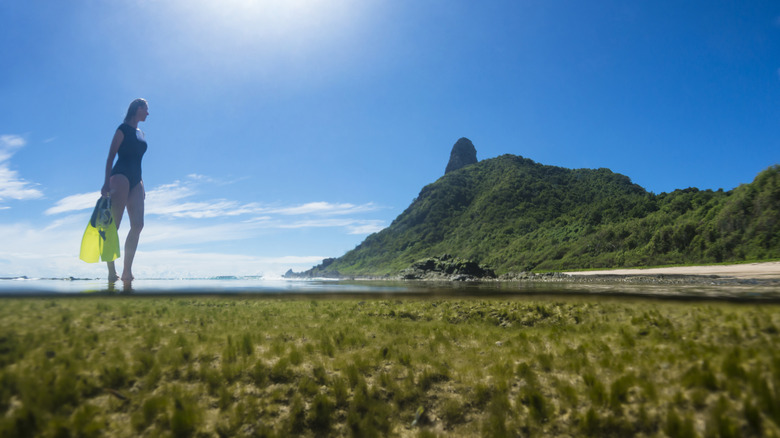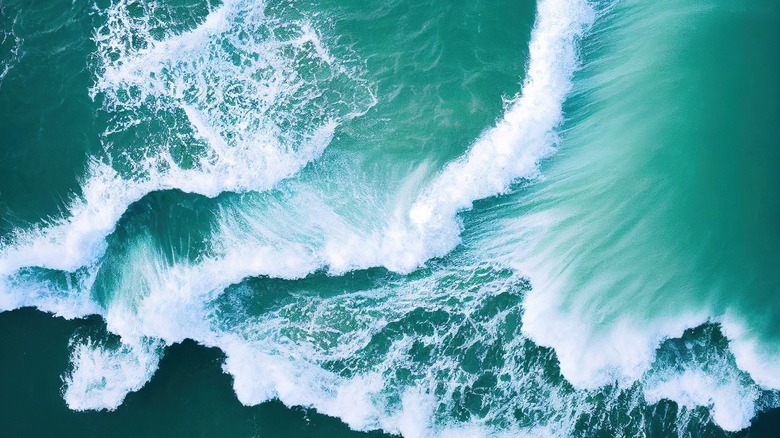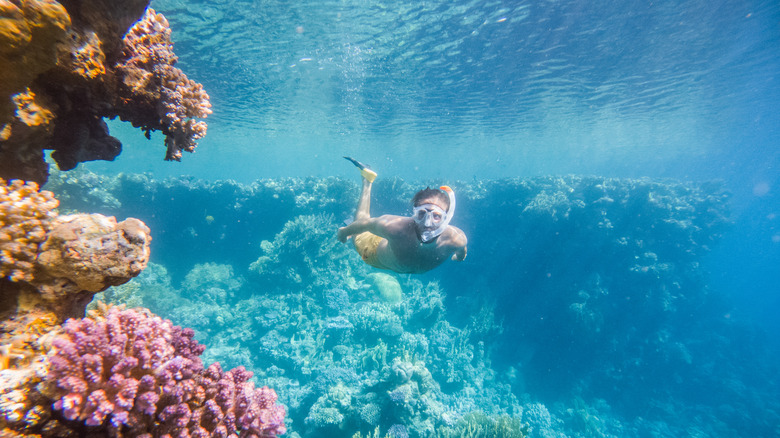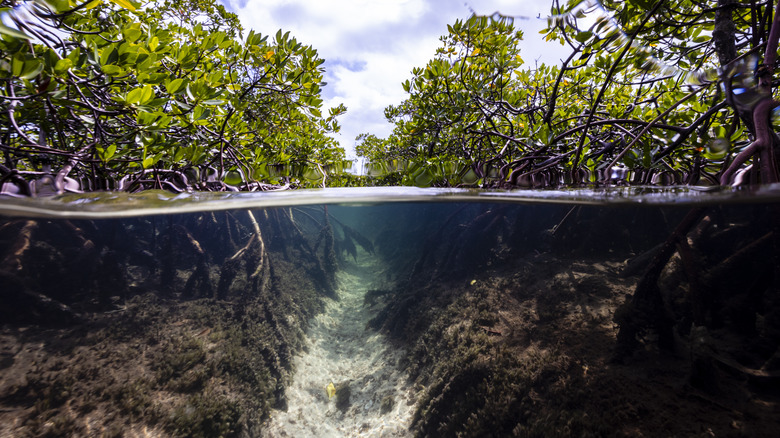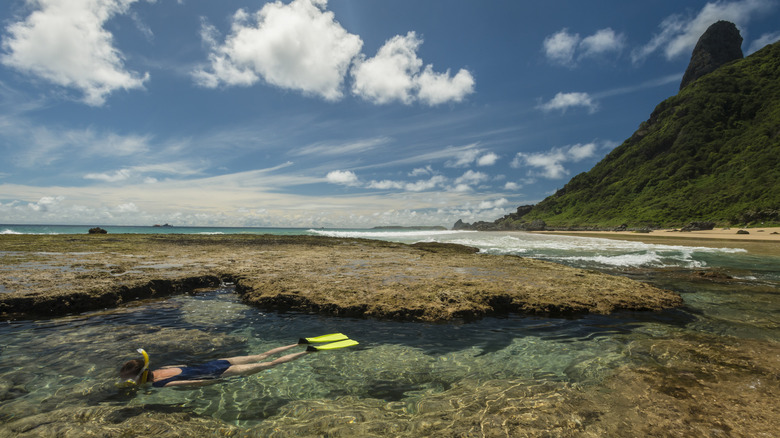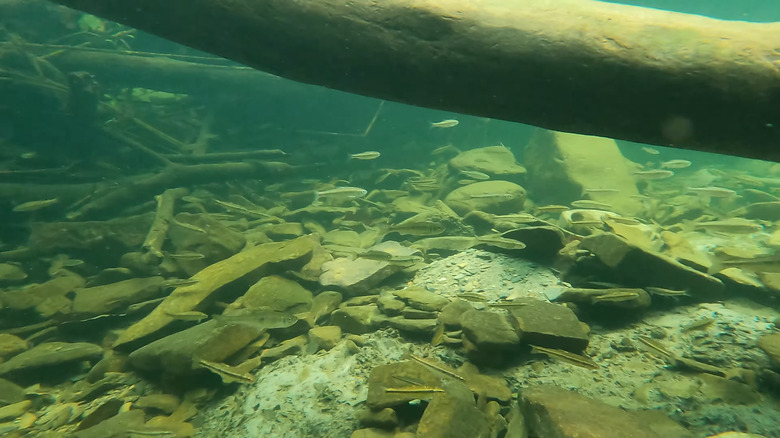Tips For Choosing The Perfect Location For Snorkeling
Planning your snorkeling trip is exciting, and anticipation builds with each passing day. By the time you're putting on your mask and flippers you can't wait to get into the water and see the incredible underwater ecosystem below the surface — but unless you've picked the right spot, you might be in for some disappointment. If you picked somewhere where there aren't a lot of fish or the water is too murky to see them, you might be able to enjoy a nice swim, but you won't get the amazing nature experience you were planning for. If the water conditions are wrong, it might even be dangerous.
If you're booking a tour in one of the top places for snorkeling in Hawaii, you won't have to worry about whether or not you've picked a spot where there is anything to see, but if you're hoping to get more off the beaten path for this trip, there are a few factors to keep in mind. If you consider what the weather will be like and what kinds of places the creatures you're hoping to see like to live, there's no reason why you can't choose the perfect spot for an underwater adventure yourself.
Keep an eye on water conditions
There are dangerous spots in the ocean that you need to avoid while snorkeling at all times, like areas prone to shore break, strong currents, or heavy boat traffic, but some conditions change with the seasons or even from day to day. The perfect spot to go snorkeling can change with the weather. If you're planning to go snorkeling in the ocean, you should check weather and sea swell forecasts for the region. The lower the swell the better, because choppy waters both make it more dangerous to be on the ocean and make it harder to see underwater, transforming your perfect snorkeling spot into a wavy, muddy mess. Similarly, you can check wind forecasts and wave patterns to see if there are likely to be big waves throwing off the trip.
While you might think more about dangerous water conditions when you're going in the ocean, you should still think about the weather when you're going freshwater snorkeling. In rivers and streams, you'll want to keep an eye on local river forecasts and monitoring sites, if they're available so that you know how hard and fast the water is going to be flowing. In the U.S., you can find this information through NOAA.
Look for clear water
The whole point of snorkeling is to get a look at what's going on under water, so you definitely want to choose a location with good visibility. There's nothing more annoying than getting out in the water only to have everything seem cloudy because of sand and dirt floating around you. While major wind and waves can stir up sediment, calmer water isn't always the answer. In areas with limited water movement, like deep bays, dirt, and sand can collect in the water, so you're better off choosing spots that aren't so isolated from ocean currents.
This can also be a safety issue. Not only does it make it harder to avoid swimming into something, but it may also make it harder for sea creatures like sharks to realize that you're a human, not a delicious turtle. While shark bites are extremely rare, it's still prudent to know what to do if you see a shark while snorkeling and do what you can to lower your risk.
Seek out the most fascinating underwater habitats
The best places to snorkel are the places with the most stunning seascapes and fascinating creatures. If you're able to travel around the world to find them, there are some incredible places to choose from. The most popular are certainly coral reefs, and it's easy to see why. They are some of the most biodiverse ecosystems on the planet, so you'll see a huge number of different species when you snorkel over them, some of which you can't see anywhere else on Earth. From Australia's Great Barrier Reef to the Florida Reef in the U.S., you can't go wrong choosing a spot where you can watch fish flitting around vibrant corals — just make sure you know how to safely snorkel around coral reefs.
Another less popular but perhaps equally incredible option is to seek out mangroves to snorkel in. Mangrove forests grow out of coastal waters, and their exposed root systems make great hiding places for fish. They are particularly vital for breeding aquatic animals, and many species lay their eggs there so that the baby fish are safe in the roots when they hatch — though you may also be lucky enough to spot some predators hunting there as well. If you're craving corals, in some places, you may even find some growing on the tree roots under the water.
Choose the right depth
In general, shallower waters are easier to snorkel in, not only because you can get out of the water if you start to feel tired but also because it's easier to see the habitat on the ocean floor or creek bed if it isn't too far below you. Most also prefer to head out to their favorite snorkeling spot at low tide for the same reason: The fish are closer to the surface. Even if you can dive down to see the bottom, in general, most of the fish you're going to see while snorkeling are more likely to be along the shoreline or in areas like reefs that are full of great spots for them to avoid predators, so deeper open water probably wouldn't be a great location to snorkel anyway.
Just because you're in shallow water doesn't mean you're completely safe, however. Snorkelers still face drowning risks in shallow water, so it's important to take precautions. If you're going to choose a freshwater aquatic habitat to snorkel in, like riffles (which are the shallowest and quickest flowing areas in streams), you won't have to worry about deadly waves. However, if you're swimming in the ocean, you should know that shallower waters, particularly those over sharp corals, can be much riskier for snorkelers if there is any risk of shore break. You should always research if the area is known for shorebreaks before choosing your spot, if you're hoping to snorkel in the shallows.
Try freshwater aquatic habitats
While most people think of gorgeous turquoise water and coral reefs when they think of snorkeling, some of the most stunning snorkeling destinations in the U.S. and around the world are freshwater. Anywhere you go, water can be home to fantastic ecosystems, and if you choose the right spot, a freshwater stream, river, or lake can be the perfect place to see wildlife underwater. Not only are there a variety of fish you can see, you might also encounter eels, frogs, and turtles in the water if you know where to go.
The best freshwater spots will let you see a few different underwater habitats to maximize the types of creatures that you'll see. As detailed by the USDA's Freshwater Snorkeling Toolkit, for instance, you may want to choose a stream that includes fast-moving riffles and deeper pools so that you get a good amount of variation during one trip. You should also prioritize areas where aquatic animals are most likely to be living. Streams with undercut banks and overhanging trees can be a great choice since fish love to hide in the darker areas and under fallen logs and branches in the water.
